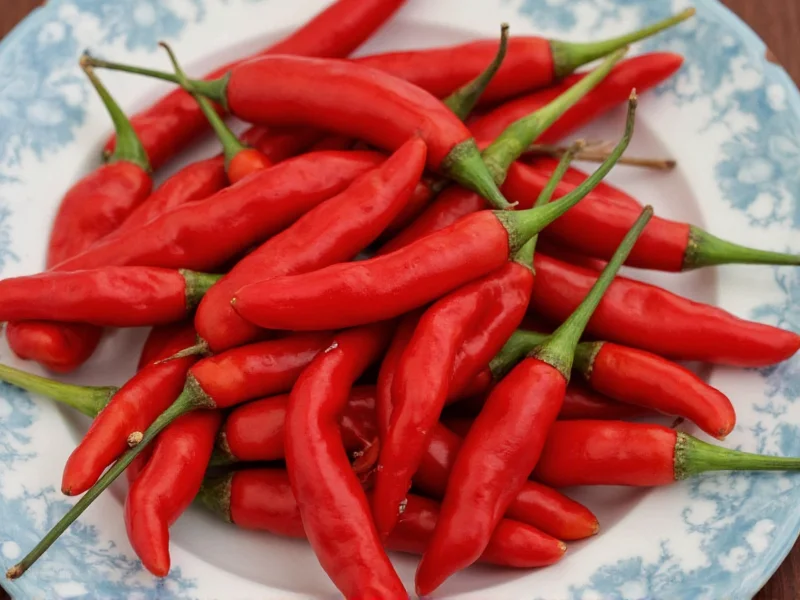Birdseye chillies represent one of the most recognizable hot peppers in global cuisine, particularly throughout Southeast Asia where they've been cultivated for centuries. These diminutive peppers pack an impressive punch despite their small size, making them a favorite among spice enthusiasts and professional chefs alike. Understanding their characteristics helps home cooks and food enthusiasts incorporate them effectively into various dishes.
Physical Characteristics of Birdseye Chillies
Visually distinctive, birdseye chillies typically measure between 1-2 inches (2.5-5 cm) in length with a diameter of approximately 0.2-0.4 inches (0.5-1 cm). They feature a characteristic pointed tip that gives them their "bird's eye" name, as the shape resembles a small eye. The peppers grow upright on the plant rather than hanging down like many other chili varieties.
Color variation provides the best indicator of ripeness and heat level. Immature birdseye chillies appear bright green, gradually transitioning through yellow and orange stages before reaching their final vibrant red color when fully ripe. Some varieties may also appear in purple or brown hues depending on growing conditions and specific cultivar.
Heat Level and Scoville Rating Comparison
When considering how hot are birdseye chillies, they consistently rank between 50,000-100,000 Scoville Heat Units (SHU), placing them firmly in the 'very hot' category. This heat level makes them approximately 6-25 times hotter than jalapeños (2,500-8,000 SHU) and comparable to cayenne peppers (30,000-50,000 SHU), though some birdseye varieties can exceed cayenne's maximum heat.
| Chili Variety | Scoville Heat Units | Heat Comparison to Birdseye |
|---|---|---|
| Birdseye Chilli | 50,000-100,000 | 1x (reference) |
| Serrano | 10,000-23,000 | 2-5x milder |
| Habanero | 100,000-350,000 | 1-3x hotter |
| Jalapeño | 2,500-8,000 | 6-25x milder |
| Thai Dragon | 50,000-100,000 | Similar heat |
The heat in birdseye chillies comes primarily from capsaicin concentrated in the white pith and seeds. Interestingly, the actual heat level can vary significantly based on growing conditions—stressors like limited water or nutrient deficiency often produce hotter peppers. This variability explains why birdseye chili heat level might differ between batches or growing regions.
Flavor Profile Beyond the Heat
While renowned for their intense heat, birdseye chillies offer more than just spiciness. They possess a bright, slightly fruity flavor with subtle grassy notes that distinguish them from other hot peppers. The flavor profile becomes more complex when cooked, developing subtle sweet undertones that balance the intense heat.
When comparing birdseye chili vs serrano varieties, birdseyes generally have a cleaner, more straightforward heat with less vegetal flavor than serranos. This makes them particularly valuable in Southeast Asian cooking where a pure, intense heat without competing flavors is desired.
Origin and Global Cultivation
Despite common association with Thai cuisine, birdseye chillies likely originated in South America and spread to Asia through ancient trade routes. They've become naturalized throughout Southeast Asia, particularly in Thailand, Vietnam, Malaysia, and Indonesia, where they're considered essential ingredients.
Today, these peppers grow successfully in tropical and subtropical climates worldwide. Commercial cultivation occurs primarily in Thailand, which exports significant quantities globally. Home gardeners in temperate regions can grow them in containers during summer months, though they require warm temperatures and plenty of sunlight to thrive.
Culinary Applications and Usage Tips
Understanding using birdseye chillies in cooking requires respect for their potency. Chefs typically use them whole, sliced, or finely minced depending on the desired heat distribution. In Thai cuisine, they're essential in dishes like som tum (green papaya salad), tom yum soup, and numerous curry pastes.
When working with these peppers, consider these practical tips:
- Always wear gloves when handling to prevent skin irritation
- Remove seeds and white membranes for reduced heat
- Add early in cooking for infused heat, late for brighter, sharper spice
- Start with half a pepper and adjust to taste—they're deceptively hot
- Balance with sweet, sour, or creamy elements to manage intensity
Storage and Preservation Methods
Fresh birdseye chillies maintain quality for 1-2 weeks when stored in a perforated plastic bag in the refrigerator's vegetable drawer. For longer preservation, consider these methods:
- Freezing: Place whole peppers in a freezer bag for up to 6 months
- Drying: Air-dry or use a food dehydrator until brittle, then store in airtight containers
- Vinegar preservation: Create chili vinegar by steeping in rice vinegar
- Oil infusion: Carefully infuse in cooking oil (requires proper food safety practices)
Dried birdseye chillies retain much of their heat but develop a more concentrated, slightly smoky flavor. Many chefs prefer using dried versions in curry pastes for deeper flavor complexity.
Substitutes When Birdseye Chillies Are Unavailable
If you're searching for where to buy birdseye chillies and can't find them, several substitutes work depending on your heat tolerance and recipe requirements:
- Serrano peppers: Milder option (about 1/4 the heat) with similar fresh flavor
- Fresno chilies: Comparable size with moderate heat and fruity notes
- Red Thai dragon chilies: Nearly identical heat and flavor profile
- Cayenne peppers: Similar heat level but different flavor profile
- Crushed red pepper flakes: Use sparingly (1/4 teaspoon flakes ≈ 1 whole birdseye)
When substituting, remember that birdseye chili substitutes require careful adjustment since heat levels vary significantly between alternatives. Start with less than you think you need and gradually increase to avoid overwhelming your dish.
Safety Considerations with Potent Peppers
Proper handling of handling hot birdseye chillies safely prevents discomfort and potential injury. The concentrated capsaicin can cause severe irritation to skin and eyes. Always follow these safety protocols:
- Wear disposable gloves during preparation
- Avoid touching face, especially eyes, while handling
- Wash hands thoroughly with soap and water after handling (even with gloves)
- Use separate cutting boards for hot peppers
- If skin irritation occurs, apply milk or yogurt to affected area
Never use water to alleviate burning sensations from capsaicin exposure, as it spreads the oil rather than neutralizing it. Dairy products containing casein work most effectively to break down capsaicin molecules.











 浙公网安备
33010002000092号
浙公网安备
33010002000092号 浙B2-20120091-4
浙B2-20120091-4